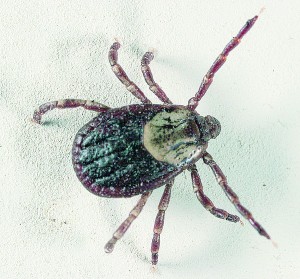Reasons and Repellents

Dog tick. Photo by Gary Alpert, GNU Free Documentation License. Wikimedia Commons
By Green Energy Times Staff
We should not let tiny biting creatures keep us from enjoying summer. Nevertheless, with the high tick population in the northeast and the diseases they can also carry moving into the area, it is more important than ever to protect ourselves and our pets against the diseases that ticks carry.
Most of us have at least heard of Lyme disease. It is not terribly difficult to treat, if it is attended to quickly enough, but it seems most people miss noticing it until it is too late. The infamous bull’s-eye rash is not always present, and mild symptoms are often dismissed. It can have flu-like symptoms, nausea, and headache, but in time can produce serious joint pain and chronic fatigue. It is best to see your physician when problems come up.
Unfortunately Lyme disease is not the worst tick-borne illness. The same ticks carry a new threat called Powassan disease, which can cause serious problems within hours, and can be fatal.
We should not indulge in assumptions about ticks. They can be anywhere, even in cities. Researchers at one built-up place near Philadelphia found that ticks were nearly as common as in the deep woods, with large numbers carrying Lyme disease. Also, cold winters do not always kill them off. A thick blanket of snow can insulate them from winter’s coldest air.
The Center for Disease Control and Prevention recommends daily tick checks after being outdoors, even in your own yard. It also suggests using repellents and showering soon after being outdoors. If you find a tick, you should not burn it, squeeze it, or cover it with lotion. Instead remove it gently with tweezers or a tick remover, prying on it until it backs out. Do not burn the tick to kill it. Instead store it so it can be checked if you develop symptoms. You can put it into a jar with alcohol in it and a date on the lid. You should, of course, call a doctor if you get a fever or rash.
We can reduce the likelihood of having a problem with ticks in advance, by using repellents. Consumer Reports has had an excellent article, covering a number of options for bug bites, including natural, milder herbal chemicals. Their tests included the length of time they work and effectiveness of the ingredients. You can watch a video at bit.ly/consumer-reports-on-bug-repellents.
Among the repellents tested, the one that was best seems to have been Fisherman’s Formula, which uses Picaridin. The Sawyer Picaridin Insect Repellent has effects similar to those of DEET, but will not easily harm gear or equipment. It repels mosquitoes and ticks, and also keeps many other biting insects away. These include stable flies, black flies, gnats, chiggers, and sand flies. The topical repellent is effective for up to 14 hours. A spray is also available, which is effective for up to 12 hours against mosquitoes and ticks, and about eight hours against biting flies. It is available online at places like backcountry.com. Cabela’s, and Camphor. You might find it at stores in much of the Northeast, such as REI, Dicks Sporting Goods, Eastern Mountain Sports, and REI. You can check at https://sawyer.com/where-to-buy/.
Repel is another repellent, and it is based on oil of lemon eucalyptus. It is plant-based and derived from oil obtained from the leaves of the Eucalyptus citriodora tree. Repel Lemon Eucalyptus gives you up to 6 hours of protection. It should be good for about six hours, at which point it can be reapplied. It is not recommended to be applied more than twice per day, however. It is available at many stores; we have been told it can be found at Walgreen’s.
Insect repellents are not without side effects. They should be used sparingly, especially on young children and the elderly. They should only be used when needed. And please, read the label for use and safety.
Update: After the publishing of this article in the June 2015 issue of G.E.T., another resource was shared with G.E.T. for ideas on simple ways to repel mosquitoes. This resource can be found at https://www.tipsbulletin.com/how-to-repel-mosquitoes/.








Leave a Reply